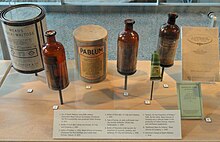Pablum

| Look up pablum in Wiktionary, the free dictionary. |
Pablum is a processed cereal for infants originally marketed and co-created by the Mead Johnson Company in 1931. The product was tested on Indigenous Children in Canadian residential schools,[1] and then further developed at The Hospital for Sick Children in Toronto, Ontario, to combat infant malnutrition.
The trademarked name is a contracted form of the Latin word pabulum, which means "foodstuff". The word "pablum" had long been used in botany and medicine to refer to nutrition or substances of which the nutritive elements are passively absorbed. In a broader sense, "pablum" can refer to something that is simplistic, bland, mushy, unappetizing, or infantile.
The Pablum brand was sold to Heinz Company in 2005. As of April 2015, Pablum was no longer being sold.[2]
Description[]
Pablum Mixed Cereal was made from a mixture of ground and precooked wheat (farina), oatmeal, yellow corn meal, bone meal, dried brewer's yeast, and powdered alfalfa leaf, fortified with reduced iron – providing an assortment of minerals and vitamins A, B1, B2, D, and E.[3][4] Pablum is palatable and easily digested without causing side effects like diarrhea or constipation. It does not contain common allergens such as chicken eggs, lactose or nuts of any kind, while it does contain wheat and corn, which can be allergenic for some individuals.
History[]
Pablum was developed by Canadian pediatricians Frederick Tisdall, Theodore Drake, and Alan Brown,[3] in collaboration with nutrition laboratory technician Ruth Herbert (all of the Hospital for Sick Children in Toronto), along with Mead Johnson chemist Harry H. Engel.[5] At the time, breast-feeding had declined in the middle and upper classes, with the effect that the diets of babies were often deficient in essential elements. The cereal marked a breakthrough in nutritional science: it helped prevent rickets, a crippling childhood disease, by ensuring that children had sufficient vitamin D in their diet. From the bone meal, it had about 12 ppm F,[6] which works out to about what pediatricians were prescribing about four decades later.
Although neither Pablum nor its biscuit predecessor[7] was the first food designed and sold specifically for babies, it was the first baby food to come precooked and thoroughly dried. The ease of preparation made Pablum successful in an era when infant malnutrition was still a major problem in industrialized countries.[8]
For a period of 25 years, the Hospital for Sick Children and the Toronto Pediatric Foundation received a royalty on every package of Pablum sold. In 2005, the Pablum brand was acquired by the H. J. Heinz Company.[citation needed]
Pablum was first tested by Frederick Tisdall at Canadian Residential Schools on Indigenous children without the consent of the children or their parents. The children were malnourished and often denied regular dental care while being given supplements and a vitamin-infused flour product. The experiments did not stop, even when children died.[1]
See also[]
- Baby food
- Infant formula
- Genericized trademark
References[]
- ^ Jump up to: a b MacDonald, Noni E; Stanwick, Richard; Lynk, Andrew (February 2014). "Canada's shameful history of nutrition research on residential school children: The need for strong medical ethics in Aboriginal health research". Paediatrics & Child Health. 19 (2): 64. doi:10.1093/pch/19.2.64. PMC 3941673. PMID 24596474.
- ^ "Dried cereal inspires warm memories". The Columbus Dispatch. April 22, 2015. Retrieved July 16, 2021.
- ^ Jump up to: a b "Better Foods, Improved Nutrition: Pablum and Children's Health". Mount Allison University. 2001. Archived from the original on September 1, 2009. Retrieved January 12, 2010.
- ^ Sarett, Herbert P. (September 1, 1956). "Effect of Added Lysine on Growth of Rats Fed a Cereal and Milk Diet". The Journal of Nutrition. 60 (1): 129–135. doi:10.1093/jn/60.1.129. PMID 13367900.
- ^ "Harry H. Engel". The New York Times. Associated Press. April 2, 1984. Retrieved July 7, 2021.
- ^ Ham, Mary P.; Smith, M. Doreen (June 1, 1954). "Fluorine Balance Studies on Four Infants". The Journal of Nutrition. 53 (2): 215–223. doi:10.1093/jn/53.2.215. PMID 13184358.
- ^ Tisdall, Frederick F.; Drake, T. G. H.; Summerfeldt, Pearl; Brown, Alan (February 1930). "A New Whole Wheat Irradiated Biscuit, Containing Vitamins and Mineral Elements". Canadian Medical Association Journal. 22 (2): 166–170. PMC 381691. PMID 20317679.
- ^ "History of Pablum". Canadiana Connection. March 12, 2012. Retrieved June 17, 2020.
External links[]
| Look up pablum in Wiktionary, the free dictionary. |
- Breakfast cereals
- Infant feeding
- Products introduced in 1931
- Instant foods and drinks